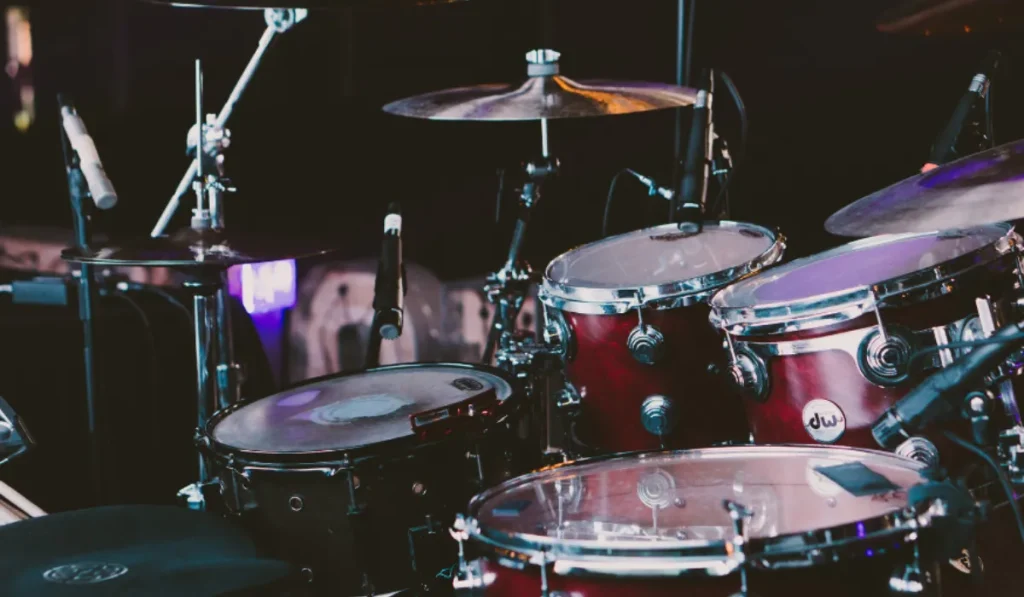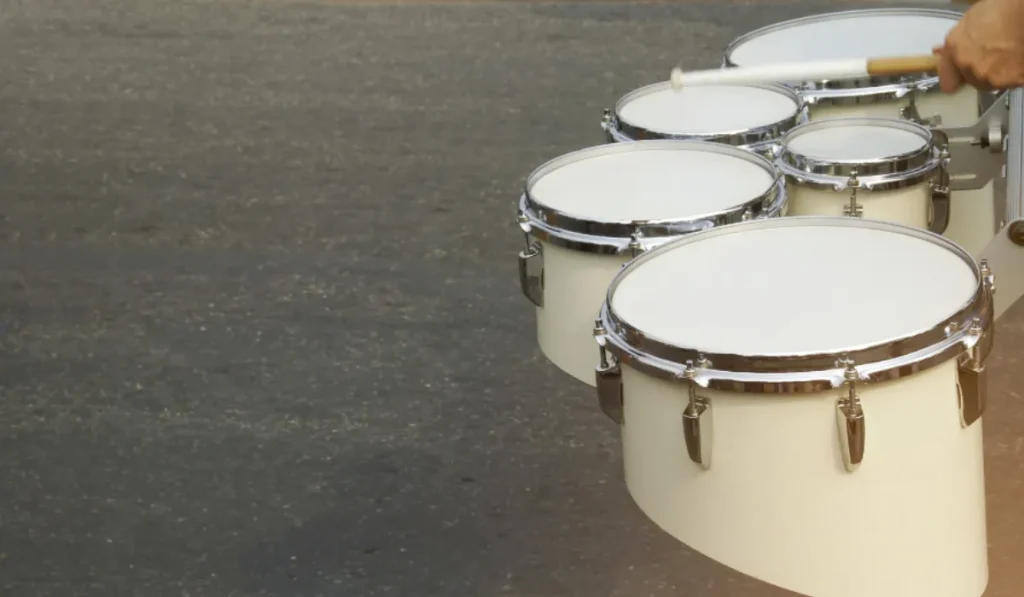Tenor drums typically weigh between 12 and 20 pounds (5.4 to 9.1 kilograms). The exact weight depends on the model and brand.
The tenor drum, an essential component of marching ensembles and pipe bands, offers a unique sound that complements the percussion section.
Despite their name, tenor drums don’t play the tenor range. Instead, they contribute rhythmic melodies using multiple pitched drums.
Their weight plays a significant role for marching musicians who must balance the need for a robust sound and the stamina to carry the instrument during performances.
Manufacturers aim to strike a perfect balance, using materials that ensure durability without making the drum too heavy.
This balance allows drummers to perform intricate rhythms without succumbing to fatigue too quickly.
As a result, knowing the weight of a tenor drum is crucial for musicians in selecting the appropriate instrument for their physical capabilities and performance needs.
The Role Of Tenor Drums In Music
The role of tenor drums in music can’t be overstated. These instruments bring a unique sound to ensembles.
From marching bands to orchestras, tenor drums fill a vital musical space. Their rich tones help create rhythm and harmony. Let’s dive into how tenor drums make an impact in different musical settings.
Tenor Drums In Marching Bands
In marching bands, tenor drums stand out. Players carry them and move in precise formations.
These drums are key for rhythm and visual effects. Marching tenors often come in sets, known as quads or quints. This setup includes multiple drums of different sizes. This allows for a range of pitches and tones.
- Quads consist of four drums
- Quints have an additional 5th drum for more pitch variety
Drummers use mallets to create complex rhythms. These sounds drive the beat for the entire band to follow.
Concert Settings And Orchestral Usage
Tenor drums also play a part in concerts and orchestras. In these settings, they provide a deep, resonant tone.
They complement other percussion instruments. Their size can vary depending on the music piece. Players usually perform on one drum at a time in this setting.
| Ensemble Type | Tenor Drum Role |
|---|---|
| Symphonic Orchestra | Supporting harmonic rhythm |
| Concert Band | Adding depth to percussive sections |
In orchestral pieces, they often emphasize dramatic moments. Their sound can be gentle or thunderous, as needed. Tenor drums enhance the musical experience for audiences.
Types Of Tenor Drums

Tenor drums have different types and features. Each type offers unique sound qualities and weight options to suit a variety of musical settings. Explore these distinct drum types with me.
Traditional Tenor Drums
Traditional tenor drums echo with history. They are key in military and classical music. Their shells, often made of wood, give them a distinct vintage tone.
- List some features of Traditional tenor drums
- Wooden shells for warm sounds
- Calfskin heads for rich vibrations
- Metal hardware for durability
Modern Marching Tenors
Modern marching tenors, or quads, dazzle in marching bands. They are lighter and robust for on-the-move performances. They often come in sets of multiple tuned drums.
| Features of Modern Marching Tenors | Benefits |
|---|---|
| Multiple drums configuration | Versatile pitches in one instrument |
| Polyester or mylar heads | Resistant to weather changes |
| Lightweight aluminum frames | Easy to carry for longer periods |
Synthetic Vs. Natural Drumheads
Drumheads make a big impact on weight and sound. Natural drumheads are heavy and sensitive to weather. Synthetic heads are light and durable.
- Compare both types of drumheads
- Natural heads: Traditional feel, heavier touch
- Synthetic heads: Weatherproof, lighter weight
Factors Affecting Tenor Drum Weight
When choosing a tenor drum, weight plays a vital role. Several factors contribute to the overall weight of your instrument.
These can include the materials from which the drum and its components are made, the size and arrangement of the drums, and the variety of hardware and accessories attached.
Materials Used In Construction
The choice of materials is crucial in determining a tenor drum’s weight. Manufacturers commonly use woods like maple or birch for the shells.
Maple offers a warm tone but can add weight, whereas birch is lighter. Some use synthetic materials, which can significantly reduce the drum’s weight while still providing durability.
Size And Number Of Drums
Tenor drums can come as a single drum or in sets, commonly known as quads, quints, or sextets. The more drums in a set, the heavier it will be. Additionally, the size of each drum also impacts the total weight.
Larger drums tend to weigh more, so a balance between size and weight is essential for ease of use, especially for marching band scenarios.
Hardware And Accessories
The weight of tenor drums is further impacted by hardware and accessories. This includes items such as rims, mounts, and harnesses.
Certain drum harnesses are designed to distribute weight more evenly, which can make a heavier drum feel lighter when worn.
Upgraded hardware options can also vary in weight, as manufacturers may offer lighter alternatives to standard parts.
Understanding these factors helps pick the right tenor drum that best suits performance needs without causing undue strain.
Average Weight Range Of Tenor Drums
The average weight range of tenor drums is critical for musicians to understand. These drums play a pivotal role in marching bands and drum corps, affecting musicians’ mobility and endurance.
Typically, the weight of tenor drums varies depending on numerous factors such as size, material, and design.
On average, tenor drums weigh between 14 to 30 pounds (6.4 to 13.6 kilograms). The weight can influence a player’s performance, hence selecting the right drum is key.
Comparing Different Tenor Drum Models
Different models of tenor drums from various manufacturers present a spectrum of weights. To illustrate:
| Brand | Model | Weight |
|---|---|---|
| Pearl | Championship Maple | 18 lbs |
| Yamaha | SFZ Series | 20 lbs |
| Tama | Marchmaster | 22 lbs |
- Pearl’s Championship Maple might be the choice for those seeking lighter options.
- The Yamaha SFZ Series offers a balance between weight and sound quality.
- Tama’s Marchmaster is for those who prefer a heavier feel.
Impact Of Customizations On Weight
Custom features can affect a tenor drum’s weight. Such features include:
- Additional drums (‘spocks’)
- Enhanced hardware
- Custom finishes
Every added element can lead to extra weight. Musicians should factor in these customizations to find a drum that is both personalized and comfortable for long marches.
Physical Demands Of Marching With Tenor Drums

The physical demands of marching with tenor drums are immense, challenging musicians with not just their musical capabilities but also their physical endurance.
Tenor drums, known for their complex configurations and rich, melodic contributions to a marching band, add a significant weight that performers must carry throughout practices and performances.
Player Endurance And Drum Weight
The endurance of tenor drum players is a fundamental aspect of their performance. On average, tenor drums can weigh between 12 to 30 pounds (5 to 14 kg), depending on the number of drums and hardware included.
- A standard quad setup includes four drums.
- Heavier setups include additional drums and cymbals.
Players must possess strong core muscles, stamina, and resilience to carry this weight, often marching for miles in parades or field shows.
Ergonomics And Carrying Systems
Ergonomic design and advanced carrying systems are essential to reduce the strain on players. These systems are tailored to distribute the weight evenly across the body.
Features of ergonomic carrying systems may include:
| Feature | Benefit |
|---|---|
| Padded Shoulder Harnesses | Decrease shoulder strain. |
| Adjustable Belly Plates | Ensure a snug fit for stability. |
| Back Support | Reduce lower back stress. |
Adequate padding and support are vital to prevent injuries, allowing players to focus on performance rather than discomfort.
Choosing The Right Tenor Drum
Tenor drums add vibrant mid-range tones to any marching band. They vary in weight, which affects how a player performs.
The perfect tenor drum balances great sound and easy handling. Let’s explore how to pick the one that hits the right note.
Balancing Sound Quality And Weight
Sound quality is a tenor drum’s soul, but so is weight management. A drum that’s too heavy might hinder movement.
Yet, lighter isn’t always better for sound depth. Look for a drum with strong projection but won’t weigh you down.
- Thicker shells offer richer sound, adding weight.
- Lightweight hardware can reduce overall mass.
- Consider composites or aluminum for a lighter feel without losing sound integrity.
Considerations For Different Performance Levels
A proper tenor drum suits the player’s expertise and the performance’s demands. Beginners need something forgiving and manageable. Professionals might opt for heavier, more resonant drums.
| Level | Drum Weight Tips |
|---|---|
| Students | Go light for ease of learning and comfort. |
| Intermediate | Select balanced weight for skill development. |
| Expert | Choose professional-grade weight for best sound. |
FAQs About the Weigh of Tenor Drums
What Is The Average Weight Of Tenor Drums?
The average weight of tenor drums ranges from 12 to 20 pounds. The variation depends on the brand, materials used, and the number of drums on the set.
How Does Drum Shell Material Affect Tenor Drum Weight?
Drum shell material notably influences tenor drum weight. Heavier woods or metals increase weight, while synthetic materials tend to make drums lighter, improving portability.
What Factors Contribute To Tenor Drum Weight Differences?
Factors include shell material, hardware, drum size, and the number of attached drums. Additional elements like carrying harnesses or stands also contribute to overall weight.
Can The Weight Of Tenor Drums Impact Performance?
Yes, heavier tenor drums can influence performance, affecting stamina and mobility. Lighter drums are generally preferred for marching scenarios due to easier maneuverability during performances.
Conclusion
Understanding the weight of tenor drums is crucial for players of all levels. Typically ranging from 12 to 20 pounds, these instruments balance heft with playability. Remember, selecting a drum that complements your physical capabilities ensures a comfortable and energetic performance.
Embrace the rhythm without the strain!
Resources:
https://www.britannica.com/summary/drum-musical-instrument
